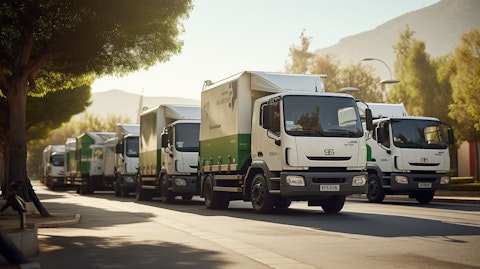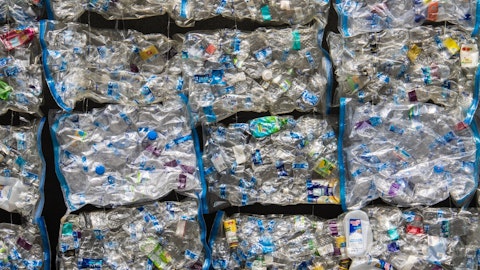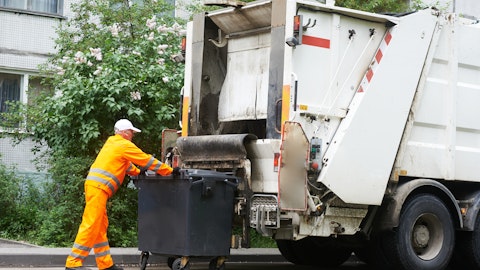Republic Services, Inc. (NYSE:RSG) Q4 2023 Earnings Call Transcript February 27, 2024
Republic Services, Inc. beats earnings expectations. Reported EPS is $1.41, expectations were $1.28. Republic Services, Inc. isn’t one of the 30 most popular stocks among hedge funds at the end of the third quarter (see the details here).
Operator: Good afternoon, and welcome to the Republic Services Fourth Quarter and Full Year 2023 Investor Conference Call. All participants will be in listen-only mode. [Operator Instructions] After today’s presentation, there will be an opportunity to ask questions. [Operator Instructions] Please note this event is being recorded. I would now like to turn the conference over to Aaron Evans, VP, Investor Relations. Please go ahead.
Aaron Evans: I would like to welcome everyone to Republic Services fourth quarter and full year 2023 conference call. Jon Vander Ark, our CEO; and Brian DelGhiaccio, our CFO, are on the call today to discuss our performance. I would like to take a moment to remind everyone that some of the information we discuss on today’s call contains forward-looking statements, which involve risks and uncertainties and may be materially different from actual results. Our SEC filings discuss factors that could cause actual results to differ materially from expectations. The material that we discuss today is time sensitive. If in the future, you listen to a rebroadcast or recording of this conference call, you should be sensitive to the date of the original call, which is February 27, 2024.
Please note that this call is property of Republic Services, Inc. Any redistribution, retransmission or rebroadcast of this call in any form without the express written consent of Republic Services is strictly prohibited. I want to point out that our SEC filings, our earnings press release, which includes GAAP reconciliation tables and a discussion of business activities, along with the recording of this call are available on Republic’s website at republicservices.com. I want to remind you that Republic’s management team routinely participates in investor conferences. When events are scheduled, the dates, times and presentations are posted on our website. With that, I’d like to turn the call over to Jon.
Jon Vander Ark: Thanks, Aaron. Good afternoon, everyone, and thank you for joining us. The Republic team finished the year strong by executing our strategy designed to profitably grow the business. We outpaced expectations throughout the year and deliver results that exceeded our full year guidance. During 2023, we achieved revenue growth of 11%, including 5% from acquisitions; generated adjusted EBITDA growth of 13%, expanded adjusted EBITDA margin by 60 basis points, including margin expansion in the underlying business of 100 basis points; reported adjusted earnings per share of $5.61; and produced $1.99 billion of adjusted free cash flow. We continue to believe that investing in value-creating acquisitions to further expand our business is the best use of our free cash flow.
We invested $1.8 billion in acquisitions in 2023, including transactions in both the recycling and waste and Environmental Solutions businesses. As part of our balanced approach to capital allocation, we returned $900 million to shareholders through dividends and share repurchases. The results we are generating are made possible by executing our strategy, supported by our differentiated capabilities. Regarding customer zeal. Our efforts to provide industry-leading service continues to drive sustained customer loyalty and organic growth in the business. Our customer retention rate remained high at over 94% and we continue to see favorable trends in our Net Promoter Score due to the value of our offerings and quality of our service delivery. We delivered outsized organic revenue growth during the fourth quarter with simultaneous increases in price and volume.
Core price and related revenue was 8.8% and average yield on related revenue was 7.7%. Organic volume growth on related revenue was 40 basis points. Turning to our digital capabilities. The team continued to advance the implementation of digital tools that improve the experience for both customers and employees. Development of our new asset management system is underway, which is expected to increase maintenance technician productivity and enhanced warranty recovery. We expect to begin utilizing the new system in late 2024. The continued operational enhancements supported by our RISE digital operations platform are expected to drive additional productivity through improved route optimization and safety performance and provide more predictable service delivery to our customers.
We anticipate the RISE platform will drive approximately $100 million of total annual earnings contribution, of which approximately $65 million has been realized to date. We continue to implement advanced technology on recycling and waste collection routes. Our platform utilizes cameras to identify overfill containers and contamination and recycling containers. This technology is reducing contamination and driving incremental revenue. Moving on to sustainability. We believe that our sustainability innovation investments in plastic circularity and renewable natural gas are a platform for profitable growth. Development of our polymer centers and Blue Polymers joint venture facilities remain on track. We are finalizing commissioning at our Las Vegas Polymer Center this week.
Delivery of plastic flake to our offtake partners is expected in the coming weeks. Construction is progressing on our Indianapolis Power Center. This development will be co-located with Blue Polymers production facility and construction at the site is expected to be completed in late 2024. The renewable gas projects being co-developed with our partners continue to advance. Five projects came online in 2023, and we expect at least eight additional projects to be completed in 2024. We continue to advance our efforts to support decarbonization, including our industry-leading commitment to fleet electrification. We currently have 11 electric collection vehicles in operation. We expect more than 50 additional EVs will be added to our recycling and waste collection fleet in 2024.

We have six facilities with commercial EV charging infrastructure, with more than 40 additional sites in various stages of development. As part of our approach to sustainability, we continue to strive to be a workplace with the best people from all background who want to work. In 2023, employee engagement improved a score of 86 with 90% — 99% of employees participating in the survey. Turnover rates continue to turn lower with full year turnover improving 400 basis points compared to the prior year. As a result, we are better staffed to optimize our operations and capitalize on growth opportunities in the market Our comprehensive sustainability performance continues to be widely recognized as Republic Services was named to the Dow Jones Sustainability Index for the eighth consecutive year.
Our 2023 results clearly demonstrate our ability to create sustainable value and our ongoing investments to strengthen the foundation from which we will continue to grow our business. With respect to 2024, we expect to deliver outsized profitable growth while continuing to make investments in the business to drive lasting value creation. More specifically, we expect full year revenue in a range of $16.1 billion to $16.2 billion. Adjusted EBITDA is expected to be in a range of $4.825 billion to $4.875 billion. We expect to deliver adjusted earnings per share in the range of $5.94 to $6, generate adjusted free cash flow in a range of $2.1 billion to $2.15 billion. Our pipeline supports continued acquisition activity in both recycling and waste and environmental solutions.
We are targeting at least $500 million of investment in value-creating acquisitions in 2024. Our 2024 financial guidance includes the rollover contribution from acquisitions that closed in 2023. I will now turn the call over to Brian, who will provide details on the quarter and year.
Brian DelGhiaccio: Thanks, Jon. Core price on total revenue was 7.2% in the fourth quarter. Core price on related revenue was 8.8%, which included open market pricing of 10.6% and restricted pricing of 6%. The components of core price on related revenue included small container of 12.3%, large container of 8.6% and residential of 8.2%. Average yield on total revenue was 6.3% and average yield on related revenue was 7.7%. In 2024, we expect average yield on total revenue in a range of 5.5% to 6%. We expect average yield on related revenue in a range of 6.5% to 7%. Yield is expected to step down sequentially during 2024 due to relatively lower index-based pricing and certain fees implemented throughout 2023, which begin to anniversary.
Fourth quarter volume on total revenue increased 30 basis points and volume on related revenue increased 40 basis points. The components of volume on related revenue included an increase in small container of 20 basis points and an increase in landfill of 7.4%. Landfill was primarily driven by a 12.7% increase in special waste revenue. Volume growth was partially offset by a decrease in large container of 1.4% and a decrease in landfill C&D volume of 2.1%, primarily due to a slowdown in construction-related activity. In 2024, we expect organic volume growth in a range of flat to positive 50 basis points. Moving on to recycling. Commodity prices were $131 per ton during the fourth quarter. This compared to $88 per ton in the prior year. Recycling processing and commodity sales increased revenue by 50 basis points during the quarter.
2023 full year commodity prices were $117 per ton. This compared to $170 per ton in the prior year. Current commodity prices are approximately $135 per ton, which is the baseline used in our 2024 guidance. Now turning to our Environmental Solutions business. Fourth quarter Environmental Solutions revenue was flat compared to the prior year. Adjusted EBITDA margin for the Environmental Solutions business was 19.7%, an increase of 250 basis points compared to the prior year. Fourth quarter total company adjusted EBITDA margin expanded 260 basis points to 29.9%, which was driven by margin expansion in the underlying business of 230 basis points. Other changes in margin performance during the quarter included a 30 basis point increase from recycled commodity prices and a 20 basis point increase from net fuel, which was partially offset by a 20 basis point decrease from acquisitions.
Our full year adjusted EBITDA margin was 29.7%, which represents margin expansion of 60 basis points, compared to the prior year. In 2024, we expect total company adjusted EBITDA margin to be approximately 30%. We expect to more than overcome a 30 basis point headwind from acquisitions. Depreciation, amortization and accretion, was 10.7% of revenue in 2023 and is expected to be approximately 11% of revenue in 2024. Full year 2023 adjusted free cash flow was $1.99 billion, an increase of 14%, compared to the prior year. This was driven by EBITDA growth in the business and the positive contribution from changes in working capital. Total debt at the end of the year was $13 billion and total liquidity was $2.7 billion. Our leverage ratio at the end of the year was 2.9 times.
We expect net interest expense of approximately $545 million in 2024. With respect to taxes, our combined tax rate and impact from equity investments in renewable energy resulted in an equivalent tax impact of 25.1% during the fourth quarter and 24.8% for the full year. We expect an equivalent tax impact of approximately 26% in 2024, made-up of an adjusted tax rate of 20% and approximately $190 million of non-cash charges from equity investments in renewable energy. The expected increase in interest expense and taxes would result in a $0.20 EPS headwind in 2024. With that, operator, I would like to open the call to questions.
See also 15 Countries with Most Car Accidents per Capita and 15 Countries with the Most Beautiful Castles in the World.
Q&A Session
Follow Republic Services Inc. (NYSE:RSG)
Follow Republic Services Inc. (NYSE:RSG)
Operator: We will now begin the question-and-answer session. [Operator Instructions] The first question comes from Toni Kaplan with Morgan Stanley. Please go ahead.
Toni Kaplan: Thank you so much. I wanted to ask about margins. In the fourth quarter, I know you mentioned a couple of factors, the commodities and fuel costs. But maybe just talk about how margins were so far ahead of the guide and what factors could continue into 2024, that could provide upside to the guidance there? Thanks.
Jon Vander Ark: Sure. Yes. Team had a really strong fourth quarter. Lots of things went in our favor, managed the middle of the P&L well. There were some one-time opportunities both on MSW and a very strong special waste fourth quarter. On that, that we felt good with, weather was actually very positive in the fourth quarter, which has slipped here in the first quarter of the year. So I feel great about that. And then, we’ve got a lot of momentum headed into 2023. Some of the event-based work, you can’t build a budget against that, right? You’ve got to look at that as a potential upside, which we’re going to go after those opportunities. But oftentimes, an election year, some of those jobs end up pushing and rolling forward. So we’re not going to build a plan based on that outsized performance that we got in Q4, but still looking at a very positive year in 2024.
Brian DelGhiaccio: Yes. And Toni, we had mentioned all year long that we expected margin expansion to sequentially improve quarter-on-quarter, ending the year with the highest level of margin expansion compared to the prior year. So, that played out exactly as we thought. Now, the margin expansion itself was a little bit stronger than we originally anticipated. But ending the year with that type of performance and the type of margin expansion in the – over 200 basis points was in line with the way we thought it would end.
Toni Kaplan: Perfect. Wanted to ask about environmental services. Maybe just talk about what you’re seeing in the different pieces there. And I think there’s a little bit flattish in the quarter. So, does that turn around next year? Thanks.
Jon Vander Ark: Yes. Most of the flatness is based on the comp. We had a really, really strong Q4 and 2022 that we were covering. Look, there is some slowdown in parts of that business, so rig counts are down, and that part of the opportunity in there. We’ve had a facility that we shut down to turnaround that we’re going to reopen here in the middle of the year. So, that will provide some incremental lift, and that was closed in the fourth quarter. And then we continue to — we’ll trade price over volume where we need to. So, we’ve turned out some less profitable customers on that and feel really good about the book and the pipeline going forward.
Toni Kaplan: Perfect. Thanks so much.
Operator: The next question is from Kevin Chiang with CIBC. Please go ahead.
Kevin Chiang: Hey, thanks for taking my question and congrats on a strong end of the year there. Maybe just on the 2024 guidance, the implied kind of 30, 40 basis points of margin expansion, reported market expansion you’re guiding to. Is there a way to think about how that splits between solid waste and ES? Is it pretty balanced between the two? Or would you expect 1 to maybe outperform the other end as you look at into 2024 here?
Brian DelGhiaccio: Yes. Look, overall, I would sit there and say that we expect margin expansion in both of the business types. We’re expecting just as — when you take a look in basis points, a little bit more on the ES side, the Environmental Solutions side, but it is still relatively balanced between the two. Just given the sheer size of the recycling and waste business relative to the Environmental Solutions business, it will drive a majority of the overall expansion when you think about the enterprise taken as a whole.
Kevin Chiang: That’s helpful. And maybe just my follow-up question. Just looking at the – your yield volume table that you provided in your disclosure. Just I noticed the strong yield in residential volumes, maybe a little bit worse than recent terms. Just wondering if you could provide some color in terms of what’s happening there? And if you’re — as you mentioned earlier, are you maybe being more purposeful in shedding maybe lower quality volume to the benefit of good yield in the fourth quarter?
Jon Vander Ark: Yes, we’re always purposeful in trading our price versus volume. I’d say in this quarter, there was a couple of contracts that went out to bid that we did — a rate that we thought was going to cover our costs and give us a fair return. We lost those opportunities. And then in previous quarters, we’ve had some nice wins, right? And these things come in fits and spurts. So, we didn’t have anything in that quarter. That’s really the combination of those two things drives the volume picture. On the pricing side, this is the manifestation of high CPI and the alternative indices over the last couple of years really flowing through our pricing, which is great to see. That’s challenged part of the yield story historically and to see that number we were really pleased with.
Kevin Chiang: Excellent. I’ll leave it there. Again, congrats on a good sets of results there.
Jon Vander Ark: Great. Thanks.
Operator: The next question is from Bryan Burgmeier with Citi. Please go ahead.
Bryan Burgmeier: Good afternoon. Thank you for taking the question. Maybe just following up on Tony’s question. I think margins typically expect kind of quarter-over-quarter from 4Q to 1Q. I imagine that will be a little bit more flattish this year. Just if you can identify maybe some of the factors weighing 1Q margins or more broadly like why historical seasonality might not apply?
Brian DelGhiaccio: Yes. Bryan, what I would say is that when you talk about historical seasonality, I think you have to go back before just the last several years kind of post-pandemic. I think you have to look at a broader data set there. So — when we came into this year, we said this year, we thought it was going to have what we would call a normal level of seasonality. And when you take a look at what that means, that would — typically, when you look at margin performance, you would have peak margin performance in Q2 and Q3 during the summer months where you’re getting some more of those seasonal volumes, in particular, on the landfill side followed by Q4. And then finally, the first quarter would seasonally be your lowest margin performance, and that’s what we’ve seen for decades.
And so we said that at the beginning of the year, that’s kind of what played out. And that’s what I would say we would also expect going into 2024 based on what we see right now. So, we would expect a sequential step down in margin from Q4 to Q1, in part, you’ve got more winter months when you’re dealing with the first quarter as well as when you just think about some of the taxes, you have your highest burden from a labor perspective in the first quarter, and those tend to max out and as you move through the balance of the year, again, some of more of those state and local taxes, then those basically reach their max in the first quarter.
Jon Vander Ark: And we had weather, right? We had mild weather in Q4 of last year. We had pretty intense weather in January, where we’ve lost some certainly some haulage and some tons. Some of that will come back, but some of that will get pushed out through the remainder of the year. So that’s what will lead to Q4 number that probably looks — our Q1 number, that product is more flat than historically might have.
Bryan Burgmeier: Got it. Got it. Thanks for all that detail. And then just following up on M&A, with the deals you completed in 4Q, did you provide a rough split for how that is divided up between the two segments? And did you provide a rollover contribution to 2024 revenue in guidance? Thanks.
Brian DelGhiaccio: Yes. Roll over contribution will be about 200 basis points from deals closed in 2023 that will have a rollover impact into 2024. Just on the split from a revenue active, it was about $200 million on the environmental solutions of the annualized revenue acquired in the fourth quarter, and about $140 million on the recycling waste side.
Bryan Burgmeier: Got it. Thanks a lot. I’ll turn it over.
Operator: The next question is from Walter Spracklin with RBC Capital Markets. Please go ahead,
Walter Spracklin: Yes. Thanks very much. Good afternoon, everyone. So I wanted to follow-up on M&A here. A big year for you in terms of deals done, I think, $1.86 billion they’re acquired. And I was wondering if you could give us an update on, first of all, what the pipeline looks like going forward, particularly relative to such a large year this past year. And then second is in terms of integration, will you be focusing a bit more given how big the year was in 2023 on integration and perhaps put a little bit on — touch a little bit on how that integration is going? Or do you see room and capacity to continue at a fairly heavy space pace here in terms of M&A for 2024.
Jon Vander Ark: Yes, we look at two things. Obviously, the strategic fit and the financial return on any type of deal, and we’re going to stay disciplined on both of those things. Are we the natural owner? And does it meet our expectation in terms of cash and cash returns. And then we do think about our ability to absorb it unless we have a lot of capacity across the enterprise. We wouldn’t necessarily do a couple of big deals in the in the same part of the country at the same time because the local team does play a pretty strong role in that day-to-day integration activity. Last year was the product of our normal tuck-ins, which we’ve done forever, and those are very value creating. It’s hard to do those deals poorly because we’ve done it for so long.
And then some nice kind of medium-sized deals. we build a plan, right, anticipated what those medium-sized dealers are going to be there, not that we’re not pursuing it, but you just don’t know when they’re going to move or when they’re going to come. So, that’s predicated on step down in our expectation this year for what we’ve done. It’s not because the pipeline is weaker — pipeline is strong, but we never know exactly what we’re going to close, and we’re going to stay disciplined.
Walter Spracklin: Got it. That’s great color. And just for my follow-up, turning to recycling. I know your Las Vegas Polymer Center opened in December. Can you talk a bit about the build-out on the polymer center — and I don’t know if you’ve had enough time now to assess, but do you see this as a better investment than kind of — or not better, but how do you — how does that compare to EPR projects in terms of the return profile of that one?
Jon Vander Ark: Yes. We’re very satisfied with both the execution and the return. We’re pretty conservative in terms of our financial modeling leaving ourselves room and we feel very good about the demand in the marketplace, we could have sold out Las Vegas five times over upfront. And the pricing expectations are ahead of what we modeled. So the returns are going to come in, again, ahead of our expectations on that front. And that’s certainly given us confidence as we talked about in the prepared remarks to go to Indy, and then we’re planning on at least two more across the country.
Walter Spracklin: Fantastic. Appreciate the time.
Operator: The next question is from John Mazzoni with Wells Fargo. Please go ahead.
John Mazzoni: Thanks for taking my question. Maybe just a quick one on pricing. Could you just remind us how the restricted book will layer through 2024especially with sort of the lag effects in CPI? Thanks.
Brian DelGhiaccio: Yes, one of the things I mentioned with respect to the cadence from a pricing perspective in my prepared remarks is we do expect a sequential step down in the level of pricing throughout the year, primarily due to the impact that, that index pricing will have. So again, we expect to report the highest level of average yield in Q1 and the lowest level in Q4 with a step down in between. Just to give you a little bit of perspective, when you take a look at the two primary components that may make up our basket that are related to some sort of index, one being headline CPI and then the other being the alternative indices. And when you take a look at headline CPI, right, it saw its peak in June of 2022, and has been stepping down sequentially since.
Water, sewer, trash and garbage trash saw peak levels in August of 23 and have been stepping down since then. Now, that said, the water sewer trash and garbage trash still remain at elevated levels, water sewer trash the recent print was 5.5% and garbage trash was 6.4%. So we’re still pretty pleased about the level, but it is going to sit there and step down just due to the math.
John Mazzoni: Great. Thank you. And maybe for a quick follow-up. Could you just talk to the strength in small container, especially with the 11.2% yield? It seems like that’s kind of update the average? And any other thing you’re seeing within that kind of end market and any other commentary around anything different that you’ve done compared to peers? Thank you.
Jon Vander Ark: Sure. Yes, we rolled out some new technology around AI, which helps us spot contamination and also helps us assess overages when the containers are overfilled. And that certainly contributed to the small container performance. Again, underlying pricing was great, but that put it on top. And that’s why we talked about our 2024 number. We expect to anniversary that in the second half of the year, so that will come down a bit.
John Mazzoni: Great. Thank you.
Operator: The next question is from Michael Hoffman with Stifel. Please go ahead.
Michael Hoffman: Hey, guys. I’ve always challenged for that full cycle, people, whatever. So free cash flow and the guide is at about 7% in the midpoint versus the top line at 7.9% and EBITDA is at $9.1 million. I’m presuming we’ve got higher interest expense and probably higher cash taxes because you’re not counting on bonus depreciation being retroactively reverted back to 100%. Is that how I think about the bridge between the growth rates through the P&L?
Brian DelGhiaccio: That’s correct, Michael. If you just take taxes alone, when you take a look at two components. So one, we are assuming that the current loss stays in place, which means bonus depreciation we’ll sit there and have a further headwind 2024 compared to 2023. Combined with the settlement we had with the IRS in 2023, where we received $20 million of cash back to a matter that dates back to 2017. Combined, those two create a $45 million headwind in cash taxes, that alone is a 2.3% headwind to year-over-year growth on free cash flow. So you just take taxes alone and you’d sit there and say you’d be kind of 9.5% growth in free cash flow or not for the impact of taxes. Interest, to your point, would just is going to be a further.
Michael Hoffman: All right. And that was what I was trying to get at. Is the underlying cash growth is there and you’ve got some timing issues related to What we just discussed? Okay. On margin…
Brian DelGhiaccio: And Michael, to that point, from an underlying business perspective, the growth in free cash flow is double digit.
Michael Hoffman: Right. Okay. That’s, I think, important. And then on margins, I think there’s another sort of message to potentially to be drawn out. So your pattern in your solid waste business, given the shield scale of managing price costs as you’re being pretty ratably able to deliver all 30 basis points. So, if the whole company is doing 30 and you’ve got an M&A headwind and act environmental comes in is a nice add in ES, but it’s probably pretty dilutive. So how do we think about that EES to dilution? It’s much better structurally ex that dilution is what I think, which–
Brian DelGhiaccio: Just to give you a perspective, if you look across, right, both business types, we’re expecting 30 basis points of dilution from acquisitions. And we would expect dilution from an acquisition perspective in both recycling and waste and Environmental Solutions. If you’re looking at the underlying business itself within ES, we’re expecting over 100 basis points of margin expansion in the Environmental Solutions business due to the underlying business itself.
Michael Hoffman: Right. And about 30 in solid waste and then a net in the total company dilution, but it’s greater in ES than it is in solid waste. It’s just one size of the deal relative to the base?
Brian DelGhiaccio: That’s correct.
Michael Hoffman: Yes. Okay. I think that’s important to draw that, you’re still on that track of 25% or better margins at ES, ex acquisitions and the acquisitions will then contribute to that as you integrate them?
Brian DelGhiaccio: Yes.
Michael Hoffman: Yes. Okay. Cool. Thanks.
Operator: The next question is from Noah Kaye with Oppenheimer & Co. Inc. Please go ahead.
Noah Kaye: Thanks Jon. Can you talk to us about this new asset management system that you’re putting in place? What are you functionally doing? And where does that ultimately show up in the P&L? Is it maintenance and repairs? What kind of savings are we talking about with the system?
Jon Vander Ark: Yes. It’s really the RISE platform. Think about digitizing our operations from our logistic operation all the way through our fleet and how our drivers operate every day. But this brings this to the maintenance shop. And so, now rather than moving paper around, right, when the driver does their vehicle condition report before they take off in the morning that digitally flows and is recorded into the maintenance organization. So they’re dealing with tablets as well. So they’re getting out of the paper-based business. And a big driver of that is the productivity benefit to that for sure, but then there’s also the warranty recovery element of that. Because when you’re chasing paper that becomes a very manual process, when you could do this digitally, it allows you to quickly understand but warranty is available? Are you fully claiming all the parts that are warranty eligible and allowing us to get full recovery?
Brian DelGhiaccio: Yes. When you think about the linkage, so a couple of years ago, we started on our journey of modernizing our core systems, and that started with our general ledger and procurement systems. This is an extension of that. So the asset management system will be directly linked and integrated on a common platform with our procurement system. So, now you can sit there and say, from the point of PO all the way to putting something on a truck, you can sit there and you can track that part. So to Jon’s point on warranty management, this is something before we had to do very manually, which means that we had a lot of leakage in the system. Now, we feel very confident that we’re going to get every single portion of that warranty that we’re entitled to.





